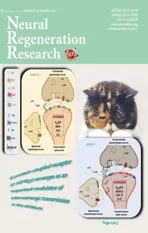MK-801 attenuates lesion expansion following acute brain injury in rats: a meta-analysis
2019-07-18NanXingYiLongYunZhouXiaoYunWangYongJiaSongHaiHuiHanTianSongZhangYongJunWangQiShiHaoXuQianQianLiangTingZhang
Nan-Xing Yi , Long-Yun Zhou , Xiao-Yun Wang Yong-Jia Song Hai-Hui Han , Tian-Song Zhang, Yong-Jun Wang Qi Shi , Hao Xu , Qian-Qian Liang , Ting Zhang
1 Longhua Hospital Affiliated to Shanghai University of Traditional Chinese Medicine, Shanghai, China
2 Institute of Spine, Shanghai University of Traditional Chinese Medicine, Shanghai, China
3 Key Laboratory of Theory and Therapy of Muscles and Bones, Ministry of Education, Shanghai, China
4 School of Rehabilitation Medicine, Shanghai University of Traditional Chinese Medicine, Shanghai, China
5 Guanghua Hospital Affiliated to Shanghai University of Traditional Chinese Medicine, Shanghai, China
6 Jing'an District Center Hospital, Fudan University, Shanghai, China
Abstract OBJECTIVE: To evaluate the efficacy and safety of MK-801 and its effect on lesion volume in rat models of acute brain injury.DATA SOURCES: Key terms were “stroke”, “brain diseases”, “brain injuries”, “brain hemorrhage, traumatic”, “acute brain injury”, “dizocilpine maleate”, “dizocilpine”, “MK-801”, “MK801”, “rat”, “rats”, “rattus” and“murine”. PubMed, Cochrane library, EMBASE, the China National Knowledge Infrastructure, WanFang database, the VIP Journal Integration Platform (VJIP) and SinoMed databases were searched from their inception dates to March 2018.DATA SELECTION: Studies were selected if they reported the effects of MK-801 in experimental acute brain injury. Two investigators independently conducted literature screening, data extraction, and methodological quality assessments.OUTCOME MEASURES: The primary outcomes included lesion volume and brain edema. The secondary outcomes included behavioral assessments with the Bederson neurological grading system and the water maze test 24 hours after brain injury.RESULTS: A total of 52 studies with 2530 samples were included in the systematic review. Seventeen of these studies had a high methodological quality. Overall, the lesion volume (34 studies, n = 966, MD =-58.31, 95% CI: -66.55 to -50.07; P < 0.00001) and degree of cerebral edema (5 studies, n = 75, MD =-1.21, 95% CI: -1.50 to -0.91; P < 0.00001) were significantly decreased in the MK-801 group compared with the control group. MK-801 improved spatial cognition assessed with the water maze test (2 studies,n = 60, MD = -10.88, 95% CI: -20.75 to -1.00; P = 0.03) and neurological function 24 hours after brain injury (11 studies, n = 335, MD = -1.04, 95% CI: -1.47 to -0.60; P < 0.00001). Subgroup analysis suggested an association of reduction in lesion volume with various injury models (34 studies, n = 966, MD =-58.31, 95% CI: -66.55 to -50.07; P = 0.004). Further network analysis showed that 0-1 mg/kg MK-801 may be the optimal dose for treatment in the middle cerebral artery occlusion animal model.CONCLUSION: MK-801 effectively reduces brain lesion volume and the degree of cerebral edema in rat models of experimental acute brain injury, providing a good neuroprotective effect. Additionally, MK-801 has a good safety profile, and its mechanism of action is well known. Thus, MK-801 may be suitable for future clinical trials and applications.
Key Words: nerve regeneration; acute brain injury; neurological function; spatial cognition; water maze test;lesion volume; brain edema; rat; systematic review; meta-analysis; neural regeneration
Introduction
Acute brain injury (ABI) primarily attributed to vascular and traumatic events is one of the leading causes of mortality and disability worldwide (Jolliffe et al., 2018). Although the incidence of stroke appears to have decreased because of the increased use of antihypertensive treatments, the proportion of young patients has rapidly risen over the past few decades (Balabanski et al., 2018). According to a nationwide survey of 0.5 million adults, approximately 2.4 million new strokes and 1.1 million stroke-related deaths occur annually in China (Wang et al., 2017). Moreover, the incidence of traumatic brain injury, with the highest mortality rate among all injuries, continues to rise (Ao et al., 2017). Traumatic brain injury accounts for 30-40% of all injury-related deaths, and half the world's population is estimated to have one or more traumatic brain injuries in their lifetime (Maas et al., 2017). ABI and the associated complications are a substantial and persistent burden for individuals and society (Kunz et al., 2018). Despite our increasing understanding of the mechanisms of ABI, effective therapeutic strategies are still lacking (Ao et al., 2017).
The progression of ABI is complex. The primary physical insult triggers acute secondary injury, involving excitotoxicity, neuroinflammation, oxidative stress, neural cell death, vasogenic edema,ionic imbalance, autophagy disorder, and a range of cellular and molecular disturbances (Duris et al., 2018). Interestingly, excessive activation of the glutamate receptor underlies these varied changes (Milton and Smith, 2018). For example, hyperactivation of N-methyl-D-aspartate (NMDA) receptors, with resulting excessive influx of Na+and Ca2+, is associated with neuronal damage after stroke and traumatic injury (Song et al., 2018). The chronic NMDA receptor hyperactivity results in the loss of neurons in neurodegenerative disorders, such as Huntington's, Parkinson's and Alzheimer's disease (Song et al., 2018). Accordingly, knockout of microglial NMDAR subunits reduces neuroinflammation and neuronal cell death induced by ABI in the developing and mature brain (Kaindl et al., 2012).
MK-801, an NMDA receptor blocker, has been successfully used in experimental therapy for stroke, traumatic brain injury,Parkinson's and peripheral neuralgia (Song et al., 2018). Despite its efficacy, the adverse side effects, which probably result from its high affinity for the receptor and long dwell time, preclude its clinical application (Song et al., 2018). However, drug use in clinical practice is dependent on risk-benefit assessment, especially for diseases currently lacking effective therapies, such as ABI. Here, we perform a systematic review of available data to critically evaluate the efficacy of MK-801 in rat models of ABI, and we assess its potential for further clinical trials and applications.
Data and Methods
Literature search
PubMed, Cochrane library, EMBASE, the China National Knowledge Infrastructure, WanFang database, the VIP Journal Integration Platform (VJIP) and SinoMed databases were searched from their inception dates to March 2018. Key terms were “stroke”, “brain diseases”, “brain injuries”, “brain hemorrhage, traumatic”, “acute brain injury”, “dizocilpine maleate”, “dizocilpine”, “MK-801”, “MK801”,“rat”, “rats”, “rattus” and “murine”. Reference lists from the included articles were also searched to identify additional studies.
Identification of articles
Two reviewers (NXY and LYZ) selected the studies independently by screening the abstracts and full texts according to the eligibility criteria. Disagreement or ambiguities were resolved by consensus after discussion with a third reviewer (TZ).
Eligibility criteria Types of studies
Controlled studies assessing the neurobiological effects of MK-801 on rats with brain injury were searched. All clinical case reports and solely in vitro studies were excluded. No language, publication date, or publication status restrictions were imposed.
Types of included animals
Laboratory rats of any age, gender or strain subjected to ABI by ischemia, hemorrhage or trauma were included. Studies featuring non-traumatic ischemia, genetically-modified animals, chronic brain injury models, radiation or electrical stimulation were excluded.
Types of treatment
All types of MK-801 treatment compared with a placebo control were included. Placebo control included dimethyl sulfoxide, saline,vehicle or no treatment. Studies with combined treatments, such as MK-801 along with memantine, were excluded.
Types of outcome measures Primary outcomes
Lesion volume is a reliable indicator of injury severity, and is related to neurological functional recovery. To accurately assess lesion volume, the dissected brain hemisphere usually includes all potential lesioned regions, and is cut into serial axial sections. By quantifying the lesioned area in each section, lesion volume can be calculated with software (e.g. Neurolucida or Stereo Investigator)or according to a specific formula. Brain edema can be used as an indicator of the brain injury process. Hours to days after the initial trauma, there is a progressive edema (swelling) of the damaged tissue. Studies reporting brain water content, as an outcome measure,using the formula [(wet weight-dry weight)/wet weight] × 100%were included in the analysis.
Secondary outcomes
Behavioral assessments with the Bederson neurological grading system or the water maze test were included. The Bederson neurological grading system (Bederson et al., 1986) is a well-documented and widely used scale with discrete values ranging from 0 to 3:Grade 0, no observable deficit; Grade 1, forelimb flexion; Grade 2,decreased resistance to lateral push (and forelimb flexion) without circling; Grade 3, same behavior as grade 2, with circling. Rats are held gently by the tail, suspended one meter above the floor, and observed for forelimb flexion. The water maze experiment documents the number of times that the pre-trained rat finds the platform and the swimming distance in the platform quadrant. It is a classic test used to evaluate spatial learning and spatial orientation abilities.
Data extraction
The data, including name of the first author, publication year, animal strain and gender, animal age and weight, number of animals,ABI model, MK-801 administration, and measured outcomes as the mean ± standard deviation (SD), were extracted from the studies. In studies with multiple intervention strategies, only data for MK-801 and negative control groups were included in the analyses.For data that were not described numerically in the text, the values from the graphs were estimated using commercial software (GetData Graph Digitizer 2.25; download from http://getdata-graph-digitizer.com). When related outcomes were reported without clearly presented data, the authors were contacted by email.
Methodological quality of individual studies
Stroke Therapy Academic Industry Roundtable (STAIR) guidelines(Fisher et al., 2009) were used to assess the quality and design of the studies, including the following: sample size calculation; inclusion and exclusion criteria; randomization; allocation concealment;reporting of animals excluded from analysis; blinded assessment of outcome; and potential conflicts of interest and study funding.Two investigators assessed the methodological quality. The bias was assessed as a low or high risk of bias, while “unclear” indicated that the risk of bias was not clear.
Statistical analysis
Pairwise meta-analyses and subgroup analyses were conducted using Review Manager 5.3 software (downloaded from https://community.cochrane.org). For all outcome measures, the significance was set at a level of 0.05 (two-tailed). Pooled data for each outcome were reported as the mean differences (MD) with 95% confidence intervals (CIs). The chi-square test and Cochrane's I2were used to assess heterogeneity between studies and subgroups. Heterogeneity was considered significant for P values of Cochrane's Q statistic< 0.10 and I2> 50%. The random effects model was used because instead of a single true effect size, the true effect sizes likely varied across the studies.
To examine the appropriate MK-801 dosage, a network meta-analysis method was conducted according to the Bayesian method using Stata software to synthesize direct and indirect treatment regimens simultaneously and compare the therapeutic effect between different doses. For every treatment dosage, we calculated the probability of its efficacy and ranked treatments by the surface under the cumulative ranking curve (SUCRA). The larger the SUCRA value for the treatment, the higher its rank among the network treatment regimens.
Results
Study selection
Our systematic search identified 1830 potentially relevant studies.After removal of duplicates and title/abstract screening, 72 papers were selected for full-text screening. Of 20 publications excluded at the full-text level, five used the newborn rat, four did not report an outcome that met the inclusion criteria, two combined MK-801 with another treatment, and the remaining were repeat publications or were excluded for other reasons. A total of 52 studies were finally included in this systematic review and meta-analysis (Park et al., 1988; Dirnagl et al., 1990; Bielenberg and Beck, 1991; Gill et al., 1991, 1992; Oh and Betz, 1991; Buchan et al., 1992; Iijima et al.,1992; Roussel et al., 1992; Hamm et al., 1993; Pschorn et al., 1993;Shapira et al., 1993; Dawson et al., 1994; Frazzini et al., 1994; Lo et al., 1994; Lyden and Lonzo, 1994; Xue et al., 1994; Green et al.,1995; Liu and Feng, 1995; Katsuta et al., 1995; Memezawa et al.,1995; Margaill et al., 1996; Relton et al., 1996; Onal et al., 1997; Bertorelli et al., 1998; Chen et al., 1998; Herz et al., 1998; Sarraf-Yazdi et al., 1998, 1999; Takamatsu et al., 1998; Ai et al., 2000; Gorgulu et al., 2000; Kawai et al., 2000; Mackensen et al., 2000; Hanon and Klitgaard, 2001; Uchida et al., 2001; Wexler et al., 2002; Pan and Li, 2003; Shen et al., 2003; Shirasaki et al., 2004; Allahtavakoli et al., 2007; Moyanova et al., 2007, 2009; Regan et al., 2007; Cam et al., 2008; Ashioti et al., 2009; Foster et al., 2009; Han et al., 2009;Nategh et al., 2010; Hu et al., 2015; Qian et al., 2016; Sommer et al.,2017; Figure 1).
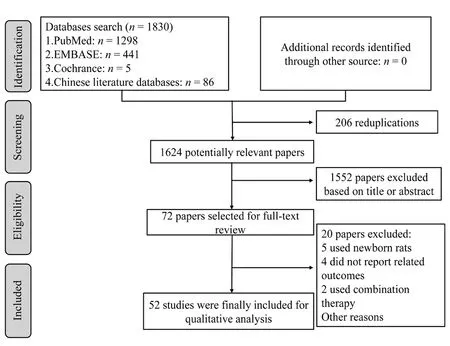
Figure 1 Summary of the literature identification and selection process.
Characteristics of the included studies in the meta-analysis
Of the 52 publications from 1988 to 2017, 48 were in English, while four were in Chinese (Liu and Feng, 1995; Wenbin et al., 2000; Pan and Li, 2003; Shen et al., 2003). The sample size (number of animals)ranged from 10 to 121. Among the studies, 41 had ABI induced by middle cerebral artery occlusion (MCAO), five used a weight-drop injury model (Hamm et al., 1993; Shapira et al., 1993; Wenbin et al., 2000; Han et al., 2009; Sommer et al., 2017), and the remaining used a hemorrhage model. Half of the studies reported the source of MK-801. The controls included saline, dimethyl sulfoxide, or no treatment. The dose of MK-801 ranged from 0.04 to 10 mg/kg, and 36 studies used intraperitoneal injection, while the remaining used intravenous injection. Pre-operation administration of MK-801 was performed in 22 studies, while the majority of the remaining studies treated ABI within 30 minutes of injury (Additional Table 1).
Risk of bias within studies
Overall, the methodological quality of the studies was relatively low.Only two of the studies reported more than 50% of the details in the STAIR list (Lyden and Lonzo, 1994; Mackensen et al., 2000). No study performed a sample size calculation. About half of the studies reported randomization, blinding to assessors and potential conflicts of interest (Table 1).
Overall analysis of the effects of MK-801
From histopathological analysis, lesion volume (mm3) expansion was notably decreased in the MK-801 group compared with the control group (34 studies, n = 966, MD = -58.31, 95% CI: -66.55 to -50.07, P < 0.00001; Figure 2). The pooled lesion volume (percentage to hemisphere volume) results revealed a protective effect of MK-801 (10 studies, n = 225, MD = -10.44, 95% CI: -13.60 to-7.28, P < 0.00001; Table 2 and Additional Figure 1). Five studies reported brain water content as outcome. MK-801 significantly decreased brain water content compared with the control group (5 studies, n = 75, MD = -1.21, 95% CI: -1.50 to -0.91, P < 0.00001;
Figure 3).
For functional evaluation, 11 studies assessed neurological scores 24 hours after brain injury. Although three trials reported that MK-801 had no beneficial effect on neurological score, our meta-analysis revealed that MK-801 significantly improved neurological function in rats with ABI (11 studies, n = 335, MD = -1.04, 95% CI:-1.47 to -0.60, P < 0.00001; Figure 4 and Table 2). The pooled water maze test results showed a significant improvement in MK-801-treated animals compared with control (two studies, n = 60, MD =-10.88, 95% CI: -20.75 to -1.00, P = 0.03; Figure 5 and Table 2).Substantial heterogeneity in treatment effects between the studies was observed. Given that different models and administration parameters may be associated with this heterogeneity, we conducted subgroup analyses on these factors.
Subgroup analysis of the effects of MK-801
MK-801 produced a notable reduction in lesion volume compared with control, in both MCAO and hemorrhage models, irrespective of administration dose, route and timing. There were no differences in the reduction in infarct volume among the different ABI models. There were also no differences among the 0-1, 1-3 and 5-10 mg/kg doses, between intraperitoneal and intravenous injection, or between pretreatment and posttreatment (Figure 6, Table 3 and Additional Figures 2-4).
Sub-subgroup analysis of the effects of MK-801 in the MCAO model
Given the large number of studies, sub-subgroup analysis for the MCAO subgroup was performed. Sub-subgroup analyses showed that controlling multiple variables produced more reliable and accurate results. Sub-subgroup analyses revealed that the reduction in lesion volume was associated with administration dose (P = 0.03),but not with administration route or timing (Figure 7, Table 4 and Additional Figures 5 and 6).
Network analysis of the effects of different administration doses of MK-801
To identify the optimum treatment regimen, network analysis of the effects of different administration doses of MK-801 was performed. Forest plots of studies of all injury models or MCAO models indicated that there were no differences in lesion volume between the 0-1, 1-3 and 5-10 mg/kg doses. Probability analysis of all injury models suggested that the effect of the 1-3 mg/kg dose had the highest probability of occupying the first ranking, with the 0-1 mg/kg dose occupying the second ranking. Probability analysis
of the MCAO models showed that the effect of the 0-1 mg/kg dose ranked first, followed by the 1-3 mg/kg dose (Figure 8).
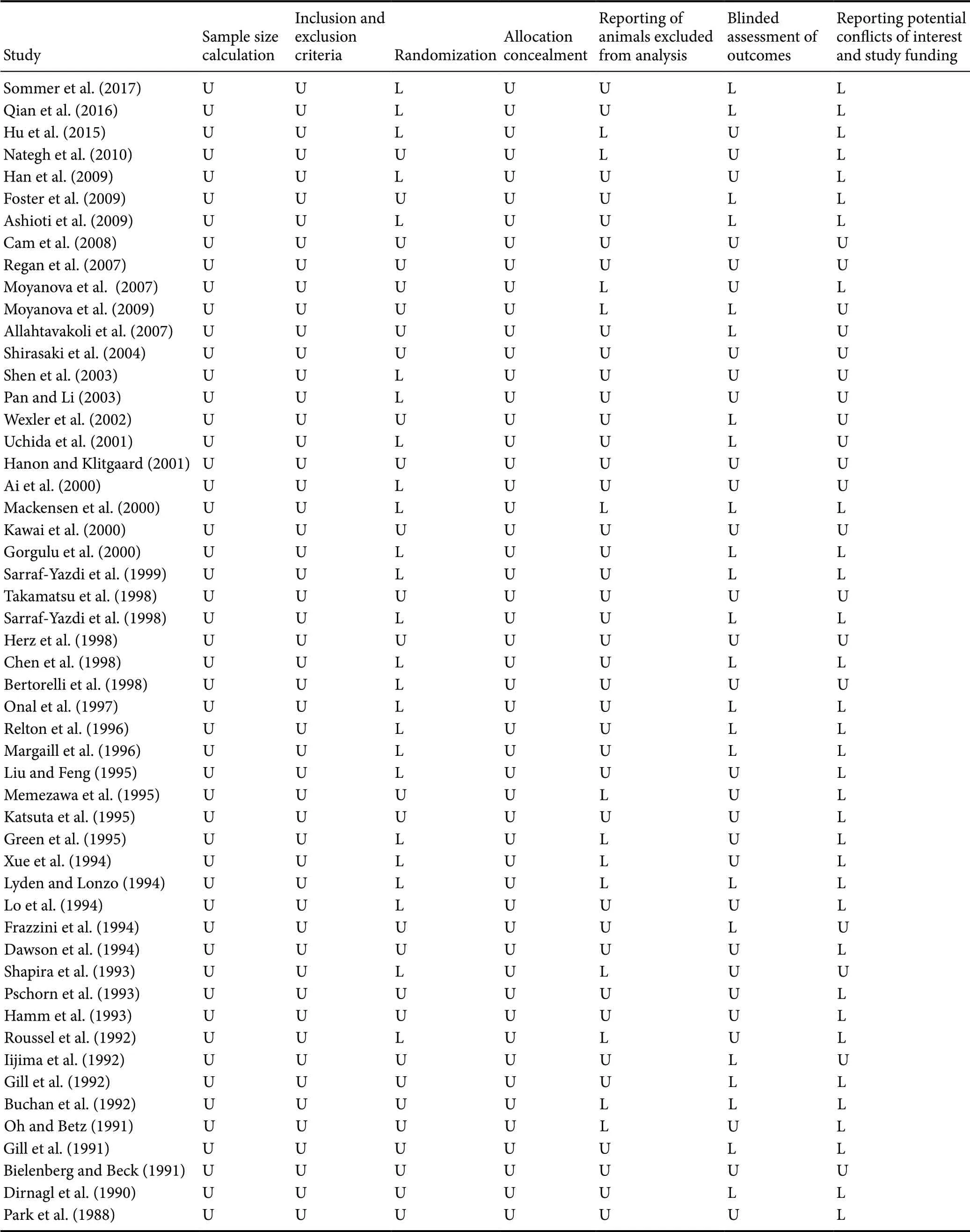
Table 1 Risk of bias summary

Table 2 Summary of the meta-analysis of lesion volume, brain water content, brain edema, neurological scores and latency in the water maze test
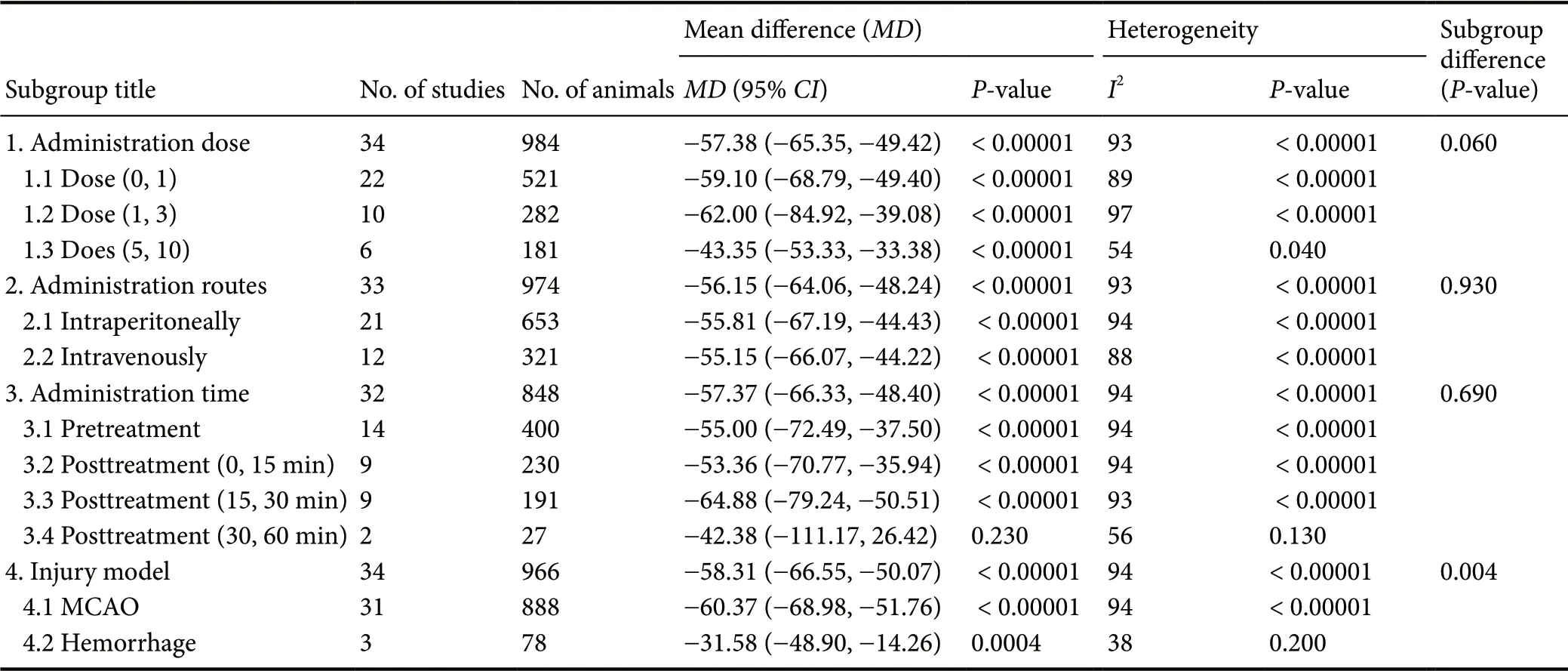
Table 3 Summary of subgroup analysis on lesion volume
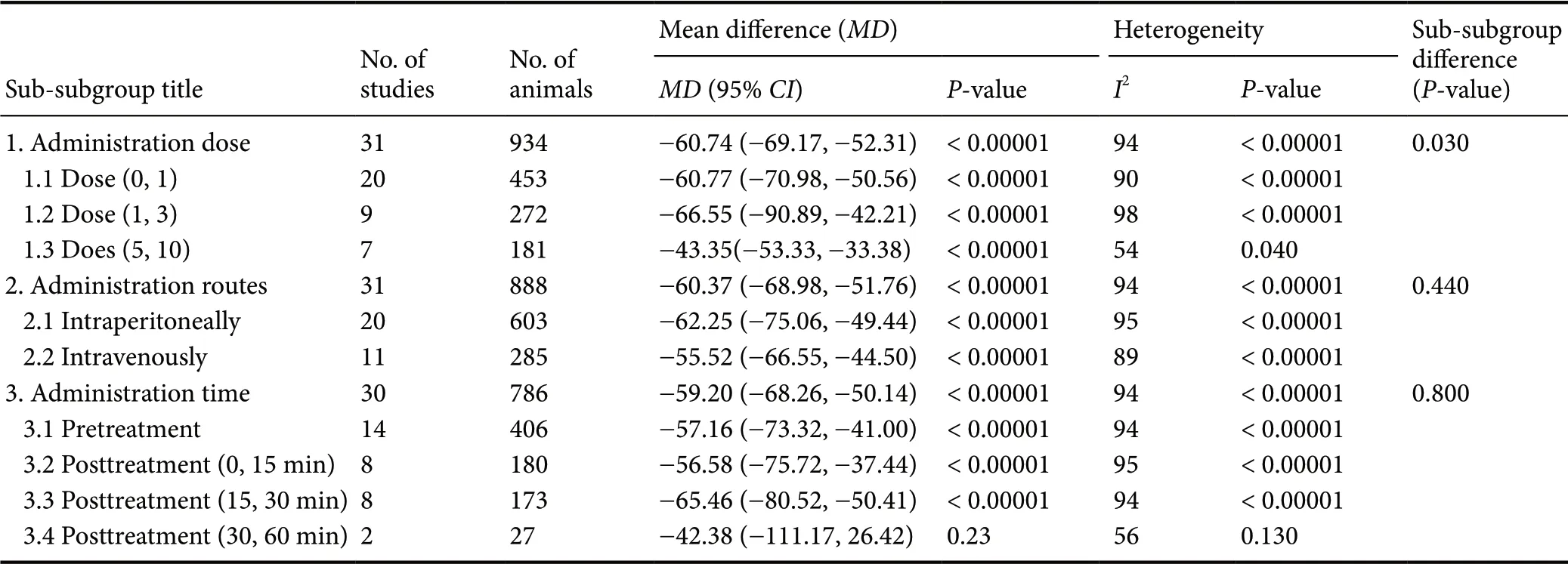
Table 4 Summary of sub-subgroup analysis of the middle cerebral artery occlusion model
Funnel plot of the effects of MK-801 on brain injury
To analyze publication bias, funnel plots of the effects of MK-801(Figure 9A) in brain injury or MCAO models (Figure 9B) were constructed. Most of the data points in this study were located above the funnel and were evenly distributed on both sides of the red indicator line, suggesting the presence of a small publication bias. A few scattered points were located on the right side of the funnel, indicating the presence of small sample effects. However,because of the systematic search and the large number of studies,the publication bias was relatively small.
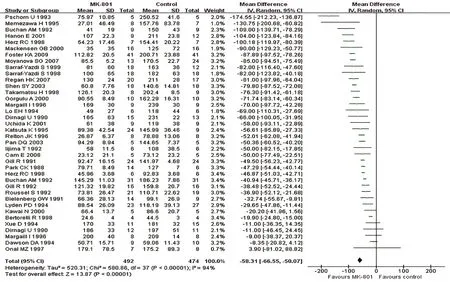
Figure 2 Meta-analysis of lesion volume (mm3)in rats after braininjury.Most studies show that MK-801 decreases lesion volume after acute brain injury in rats.

Figure 3 Meta-analysis of brain water content in rats after brain injury.Most studies show that MK-801 decreases brain water content after acute brain injury in rats.
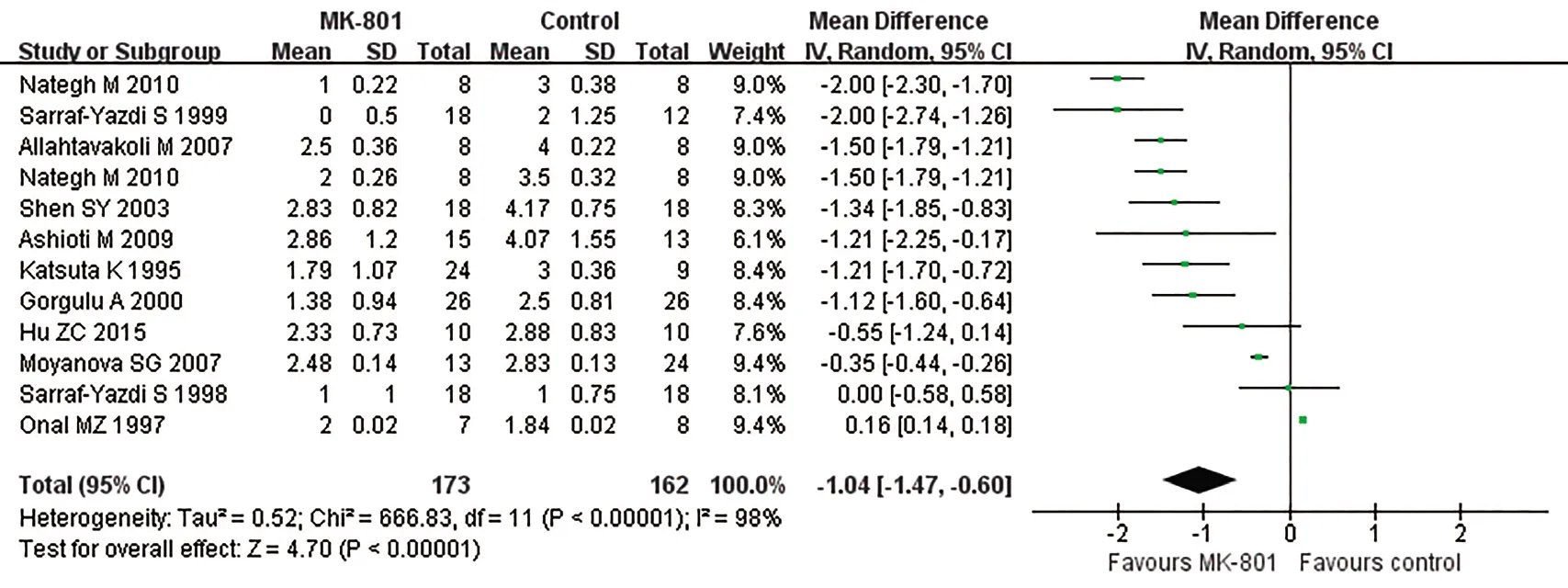
Figure 4 Meta-analysis of 24-hour neurological scores in rats after brain injury.Most studies show that MK-801 improves neurological function after acute brain injury in rats.

Figure 5 Meta-analysis of latency in the water maze test in rats after brain injury.Most studies show that MK-801 improves spatial learning and memory after acute brain injury in rats.
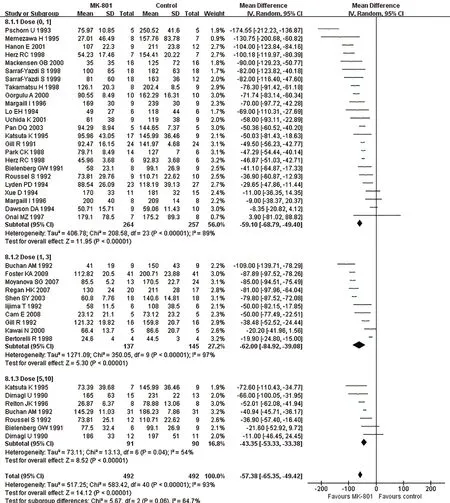
Figure 6 Lesion volume subgroup analysis of administration dose after brain injury.Most studies show that MK-801 at various doses reduces lesion volume after acute brain injury in rats.
Discussion
Despite the enormous funding and research into treatments for ABI,there are very few effective therapies available in the clinic. For translation to the clinic, treatments must have satisfactory efficacy, have high safety, with minor or no side effects, and have a well-defined molecular mechanism of action. Given the reported beneficial roles of MK-801 in ABI, we performed a systematic review of all available studies to critically assess its potential for clinical translation.
Summary of evidence
Using a sensitive and exhaustive literature search strategy, we identified 52 eligible studies. The methodological quality of these studies is relatively low. Random-effects meta-analysis suggested that MK-801 has beneficial effects in ABI. It reduced lesion volume and brain edema, and improved neurological scores. Treatment with MK-801 led to a 58.31 mm3reduction in lesion volume, a 1.21%reduction in brain water content, and better spatial cognition.
Our subgroup analysis revealed no significant difference in reduction of lesion volume between the various injury models, administration routes, timings or doses. The sub-subgroup analysis of the MCAO model showed that reduction in lesion volume was associated with administration dose. Reduction of lesion volume was greater with the 0-1 mg/kg dose than with the 5-10 mg/kg dose.Further network meta-analysis confirmed this finding.
Injury type
The studies reported that MK-801 reduces lesion size, alleviates cerebral edema and improves cognition in traumatic brain injury and ischemic or hemorrhagic stroke models. Our subgroup analysis indicated that MK-801 reduces lesion size in both ischemic and hemorrhagic stroke models, and has a better effect in MCAO models.However, only three studies using this model were included in the analysis (Lyden and Lonzo, 1994; Kawai et al., 2000; Uchida et al.,2001), and therefore, further study is needed to clarify the effects of MK-801 in hemorrhagic stroke.
MK-801 dose
Optimal dose is critical for treating any disease. The dose of MK-801 in the studies ranged from 0.04 to 10 mg/kg, and most used a dose of 1 mg/kg. Although all doses have been reported to have positive effects on ABI, doses above 5 mg/kg were associated with high mortality with obvious side effects, while 2.5 mg/kg was associated with low mortality (Dawson et al., 1994). We found that reduction of lesion volume was not significantly different among the 0-1, 1-3 and 5-10 mg/kg doses, but a relatively low effect size was found for 5 mg/kg. Sub-subgroup analysis of the MCAO model suggested that reduction of lesion volume was more pronounced in studies using doses of 0-1 mg/kg than 5-10 mg/kg.Moreover, network analysis indicated that the 0-1 mg/kg dose is more effective in comparison with the 1-3 and 5-10 mg/kg doses.These findings suggest that a low dose with few side effects should be recommended, especially for brain ischemic disease.
Timing of MK-801 administration
The pathogenesis of ABI follows a distinct temporal sequence of events, and therefore, the timing of treatment is critical for effective therapy. One study reported a greater reduction in infarct volume in animals given post-occlusion treatment with MK-801 compared with animals given pretreatment (Shapira et al., 1993). In another study, pretreatment alone failed to reduce neocortical damage after focal cerebral ischemia (Dawson et al., 1994). As the occurrence of ABI is unpredictable, pre-administration is not clinically feasible,except in situations such as cardiothoracic surgery, which may induce ischemic ABI. Our subgroup and sub-subgroup analyses showed that lesion volume reduction was not significantly different among the various administration timings (i.e. pretreatment, and 0-15, 15-30 and 30-60 minutes post-injury). Early treatment of secondary damage in ABI is crucial for improving the later regeneration of injured neurons and for the recovery of neurological function. Therefore, early administration of MK-801 should be more neuroprotective.
Administration route
MK-801 given by intravenous injection exerted neuroprotective effects in various studies on ABI. Our subgroup analysis suggested that infarct volume was not associated with administration route(intraperitoneal or intravenous injection). In the clinic, intravenous injection may therefore be an appropriate choice if MK-801 makes it to clinical trial.
Safety
Although high-dose MK-801 for treating ABI is associated with certain side effects, the concept of safety takes into consideration not only adverse reactions, but also the ratio of median effective dose to median lethal dose. In animal studies, doses of 0.04-10 mg/kg have been shown to be neuroprotective, and only minor side effects were reported with initial administration of 2.5 mg/kg MK-801 followed by 1.25 mg/kg at 6 and 14 hours (Buchan et al., 1992).Hence, there is a large separation between the effective and risk doses.
Behavioral impairment and neuronal degeneration following MK-801 administration have been reported in a large number of studies. However, most of these studies used normal animals given chronic MK-801 administration. Although hyperactivation of NMDA receptors is a key pathological event in central nervous system injury, the normal physiological function of the receptor is critical for neuronal excitability and homeostasis. The loss of physiological NMDA receptors leads to robust neuroinflammation,death of neural cells and neuronal degeneration. In ABI, MK-801 likely reduces the hyperactivation of NMDA receptors, rather than inhibiting their normal function.
In ABI, MK-801 primarily serves to reverse the acute damage,with a relatively low risk of inhibiting the normal physiological function of NMDA receptors. However, it also alleviates secondary damage in a therapeutically safe manner. The beneficial effects of MK-801 therefore seem to far outweigh the risk. Derivatives of MK-801, produced by structural modification, might further enhance safety and may be even more suitable for future clinical translation.
Potential therapeutic mechanisms
Excessive activation of NMDA receptors is associated with key pathological changes in ABI. Given that MK-801 is an NMDA receptor antagonist, it may act via a number of different mechanisms to protect against ABI (Kaindl et al., 2012; Olmos and Lladó, 2014;Figure 10).
Reduction of neuronal loss
Glutamate release in the area of primary damage and the subsequent inflammation stimulate neuronal NMDA receptors and leads to excessive cell death (Ye et al., 2013; Matute, 2007). MK-801 reduces lesion volume, neuronal cell loss and brain edema by lessening neurotoxicity induced by the intracellular accumulation of Na+and Ca2+(Bakiri et al., 2008; Han et al., 2009; Dong et al.,2017). Activation of mitogen-activated protein kinases (MAPKs),endoplasmic reticulum stress and the caspase proteins are strongly linked to cell death (Dong et al., 2017; Tran et al., 2017). MK-801 has been shown to affect c-Jun N-terminal kinase, p38 MAPK,caspase-3 and Bax signaling (Wang et al., 2011; Sanchez et al., 2016;Tran et al., 2017). Furthermore, MK-801 protects against oligodendrocyte death and demyelination by reducing Ca2+overload in the cytosol (Matute, 2007).
Neuroinflammation modulation
Rapid activation of microglia and astrocytes following the initial trauma induces the inflammatory response, further leading to disruption of the blood-brain barrier and the recruitment of peripheral immune cells in the lesion area (Kuhlmann et al., 2009;Kaindl et al., 2012). The NMDA receptor has been argued to play an important role in microglial activation (Li et al., 2017). Glutamate, NMDA, interleukin-1β and tumor necrosis factor-α promote microglial activation by directly or indirectly activating NMDA receptors (Matute, 2007; Ye et al., 2013; Olmos and Lladó, 2014).Blocking NMDA receptors with MK-801 prevents the inflammation triggered by microglial activation and the ensuing neurotoxicity (Streit et al., 1992; Morkuniene et al., 2015). MAPK, protein kinase C, nuclear factor-kappa B (NF-κB), Janus kinase (JAK)/signal transducer and activator of transcription 3 (STAT3) are important downstream effectors of the NMDA receptor that are involved in microglial M1 polarization. These signaling effectors are downregulated by MK-801 in vivo and in vitro (Kawamoto et al., 2012;Chen et al., 2017; Liu et al., 2017; Ding et al., 2018). Therefore, MK-801 may reduce neuroinflammation by inhibiting activation of the NMDA receptor and its downstream effectors (de Sá Lima et al.,2013; Li et al., 2017).
Antioxidant stress
Oxidative stress, primarily resulting from mitochondrial or endoplasmic reticulum dysfunction, is a key factor in various pathological and functional changes (Dong et al., 2017; Chien et al., 2018).Excessive reactive oxygen species production can lead to inflammation, perturbation of ionic homeostasis, DNA damage and cell death in the central nervous system (Kaindl et al., 2012; Milton and Smith, 2018; Nagalakshmi et al., 2018). Hyperactivation of NMDA receptors contributes to excessive Ca2+influx, a decrease in superoxide dismutase, and an increase in oxidative stress (Zieminska et al., 2017). MK-801 protects against mitochondrial and endoplasmic reticulum dysfunction by inhibiting oxidative stress and reactive oxygen species production (Massari et al., 2016; Dong et al., 2017).Although the underlying molecular mechanisms are still unclear,MK-801 may exert neuroprotection by reducing Ca2+influx and inhibiting protein kinase C signaling (Liu et al., 2017; Zieminska et al., 2017).
Hyperactivation of NMDA receptors leads to astrogliosis and glial scarring (Ebrahimi et al., 2012). MK-801 treatment in neuropathic pain models inhibits astrocyte activation and glial fibrillary acidic protein expression (Wang et al., 2017; Jha et al., 2018). The extracellular signal-regulated kinase or JAK/STAT3 signal associated with the NMDA receptor may be involved in the anti-astrogliotic effect of MK-801 (Sutton and Chandler, 2002; Sriram et al., 2004).
Regulation of neurotrophic factors
Brain-derived neurotrophic factor (BDNF), a member of the neurotrophin family of signaling molecules, plays a key role in neuroplasticity and neuroregeneration (Garraway et al., 2016).Pro-BDNF, the precursor protein, may exert some effects that are opposite to those of mature BDNF (Zhao et al., 2017). A variety of studies have reported an upregulation of BDNF mRNA associated with the activation of NMDA reporter in the cerebral cortex and hippocampus during the early stage of traumatic brain injury and ischemic stroke (Hughes et al., 1993; Felderhoff-Mueser et al., 2002;Sönmez et al., 2015; Zhao et al., 2017). Transcriptional activation of the BDNF gene increases production of pro-BDNF, leading to activation of p75NTR, which may exacerbate brain injury (Garraway et al., 2016). MK-801 administration in rats with brain injury suppresses the excessive increase in BDNF mRNA, and might therefore reduce the production of pro-BDNF to inhibit the events leading to microglial proliferation, oxidative stress and neural cell death(Dietrich et al., 2000; Zhu et al., 2015). Following the acute phase,the expression of BDNF mRNA and protein gradually decreases(Al-Amin et al., 2011). It was suggested that stroke patients in the chronic stage have lower BDNF levels compared with healthy participants (Pascotini et al., 2018). Interestingly, MK-801 administration was reported to reverse the lower expression of BDNF protein in rats with neuropathy during the subacute and chronic stages,and to be neuroprotective against neuronal loss and the associated cognitive impairment (Sönmez et al., 2015). The neuroprotective effect of MK-801 might involve BDNF-mediated CREB activation(You et al., 2019). However, the complex relationship between MK-801 and BDNF is still poorly understood.
Strengths and limitations
To our knowledge, our present study is the first meta-analysis to quantitatively evaluate MK-801 efficacy, in an effort to assess its potential for clinical trials and translation. An understanding of the optimal timing and route of administration, dose, efficacy, safety and mechanism of action of a drug is crucial for effective clinical translation. Here, we combined systematic review and traditional review to comprehensively analyze these parameters for MK-801.
Controlling variables is key to assessing the effects of a drug.Traditional subgroup analysis can only control for a single variable,and the remaining heterogeneity can diminish the credibility of the pooled results. Therefore, subgroup analysis is a feasible method for reducing heterogeneity and obtaining more reliable results. Given the high heterogeneity in subgroup analysis, we conducted sub-subgroup analysis for the MCAO subgroup. Despite no obvious reduction in heterogeneity, our findings show that MK-801 is effective for ischemic brain injury. Furthermore, our analyses suggest that the NMDA receptor is a promising pharmacological target for ABI treatment. Our findings should advance our understanding of the underlying pathological mechanisms and promote the development of new effective therapies for ABI.
Substantial between-study heterogeneity for treatment effect was identified in our review, which may seem a barrier to a meaningful analysis. Heterogeneity is usually a complicated problem. Complex variables likely contribute to the heterogeneity. It is difficult to reduce the heterogeneity by subgroup analysis, which can only limit one or two variables. The use of meta-analysis for heterogeneous studies is akin to comparing apples with oranges. However, a large number of studies with a consistent result can enhance reliability.
Unfortunately, studies of traumatic brain injury or hemorrhagic brain injury are limited. The pooled meta-analysis results mirrored the efficacy of MK-801 in the MCAO model. The neuroprotective effects of MK-801 in traumatic brain injury and hemorrhagic brain injury remain to be confirmed by high-quality studies. Finally, as most journals publish articles with positive results, and as some authors may selectively report the beneficial over adverse outcomes,there is a potential treatment bias in the present study.
In this study, data points in the funnel plots did not observe a fully symmetric distribution, indicating a small publication bias. The bias may occur in the original study or in the selection process for inclusion in the study. Additionally, most journals publish articles with positive results, and some authors selectively report the beneficial outcomes over adverse outcomes, which may also contribute to the publication bias. The reporting bias in studies is an important factor impacting the reliability of the pooled results. Finally, financial funding is an important source of heterogeneity, and some of the studies did not report potential conflicts of interest.
MK-801 is an old drug that has been investigated for many years,and therefore has an advantage over new drugs that are not well characterized. Our current findings suggest that MK-801 has a clear neuroprotective action in models of ABI. As a corollary, our findings also suggest that the NMDA receptor is a promising pharmacological target for ABI treatment. The beneficial effects of MK-801 appear to far outweigh its adverse effects. MK-801 is therefore likely suitable for further clinical trials and may have therapeutic efficacy in the clinical treatment of ABI. However, the results should be interpreted in light of the limitations in experimental design and methodological quality of the studies included in the meta-analysis.
Author contributions:Review conception: NXY, HX, TZ; electronic literature search: NXY, LYZ; manual literature search: YJS, XYW; study selection and data extraction: NXY, LYZ, QQL; quality implementation: QQL, TSZ; external advisers: YJW, QS; data analysis: NXY, LYZ, HX, TZ; initial draft writing:NXY, LYZ, XYW, YJS, HHH; manuscript revision: QQL, HX, TZ. All authors approved the final version of the paper.
Conflicts of interest: The authors declare no conflicts of interest.
Financial support:This work was supported by the National Natural Science Foundation of China, No. 81822050 (to QQL), 81873321 (to HX), 81673990(to QQL), 81330085 (to QS), 81730107 (to YJW); the Shanghai Municipal Health and Family Planning Commission TCM Research Project of China,No. 2018JP014 (to HX); the Three-Year Action Plan to Promote Clinical Skills and Clinical Innovation in Municipal Hospitals of China, No. 16CR1017A (to YJW); the Shanghai Traditional Chinese Medicine Chronic Disease [Malignant Tumor, Bone Degenerative Disease] Clinical Medical Center of China,No. 2017ZZ01010 (to YJW); the National Ministry of Education Innovation Team of China, No. IRT1270 (to YJW); the Innovation Team of Key Fields of the Ministry of Science and Technology of China, No. 2015RA4002 (to YJW);the Outstanding Principle Investigator Project of Guanghua Hospital, Changning District, Shanghai, China, No. 2016-01 (to QS), 2016-06 (to YJW). The funding bodies played no role in the study design, in the collection, analysis and interpretation of data, in the writing of the paper, and in the decision to submit the paper for publication.
Reporting statement:This study followed the Preferred Reporting Items for Systematic reviews and Meta-Analyses (PRISMA) statement.
Copyright license agreement:The Copyright License Agreement has been signed by all authors before publication.
Data sharing statement: The datasets analyzed during the current study are available from the corresponding author on reasonable request.
Plagiarism check: Checked twice by iThenticate.
Peer review:Externally peer reviewed.
Open access statement: This is an open access journal, and articles are distributed under the terms of the Creative Commons Attribution-Non-Commercial-ShareAlike 4.0 License, which allows others to remix, tweak, and build upon the work non-commercially, as long as appropriate credit is given and the new creations are licensed under the identical terms.
Open peer reviewer:Laura Romina Caltana, Universidad de Buenos Aires,Argentina.
Additional files:
Additional Table 1:Characteristics of studies included in the meta-analysis.
Additional Figure 1: Lesion volume (%) meta-analysis of rats after brain injury.
Additional Figure 2: Lesion volume subgroup analysis concerning administration routes after brain injury.
Additional Figure 3:Lesion volume subgroup analysis concerning administration time after brain injury.
Additional Figure 4:Lesion volume subgroup analysis concerning injury model after brain injury.
Additional Figure 5:MCAO sub-subgroup analysis concerning administration routes after brain injury.
Additional Figure 6:MCAO sub-subgroup analysis concerning administration time after brain injury.
Additional file 1:Open peer review report 1.
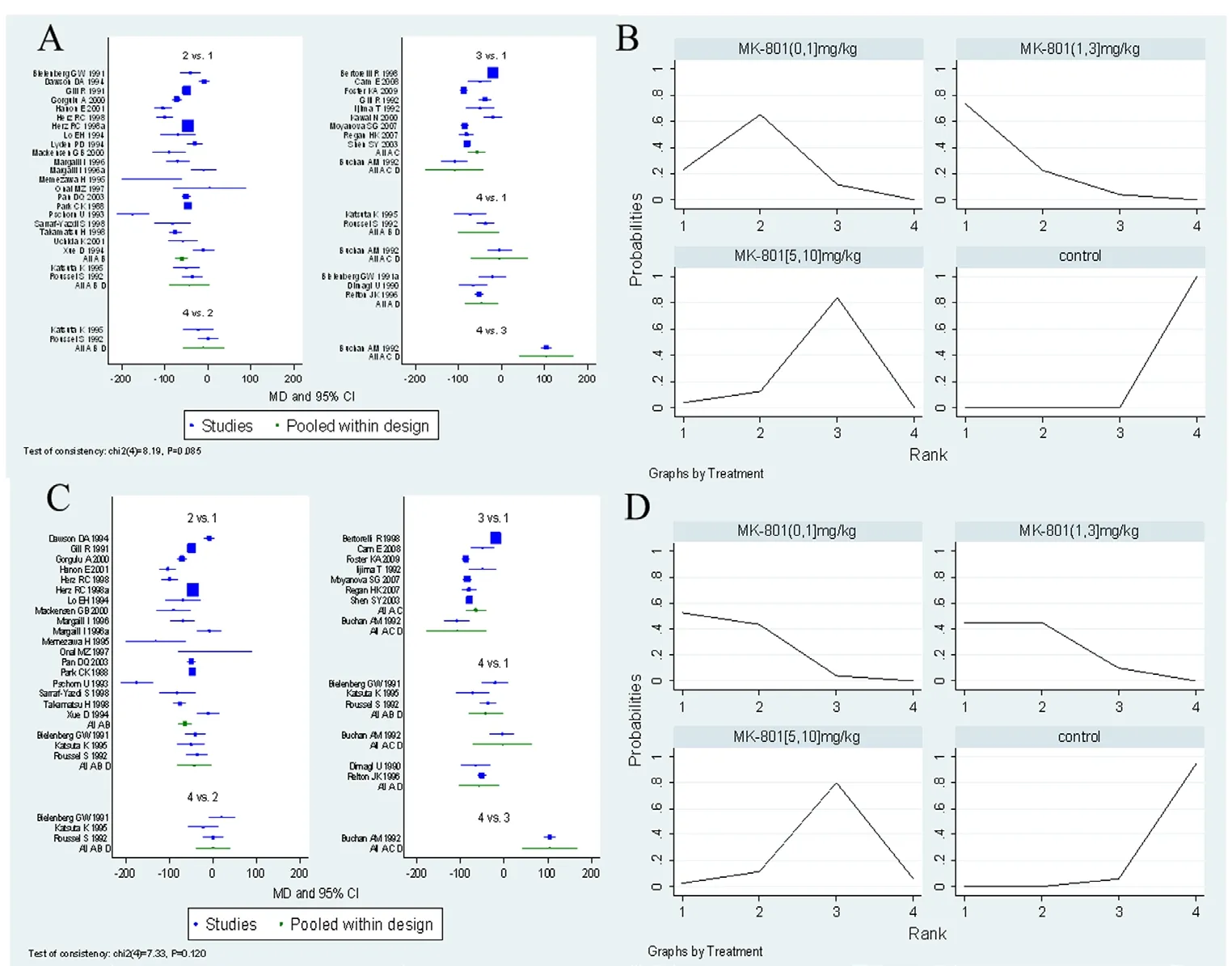
Figure 8 Network analysis of the effects of MK-801 administration dose.(A) Forest plot of pairwise comparison of different MK-801 doses according to subgroup. (B) Probability analysis of different sequences in studies of all injury models. (C)Forest plot of pairwise comparison of different MK-801 doses according to sub-subgroup. (D) Probability analysis of different sequences in studies of MCAO models. 1: Control; 2: 0-1 mg; 3: 1-3 mg; 4: 5-10 mg.
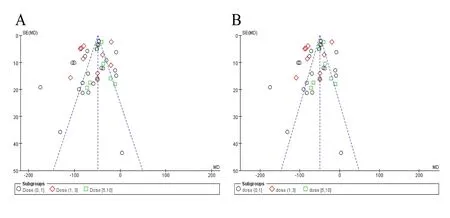
Figure 9 Funnel plot analysis.(A) Funnel plot analysis of the effects of MK-801 on brain injury. (B)Funnel plot analysis of the effects of MK-801 in the middle cerebral artery occlusion model subgroup.
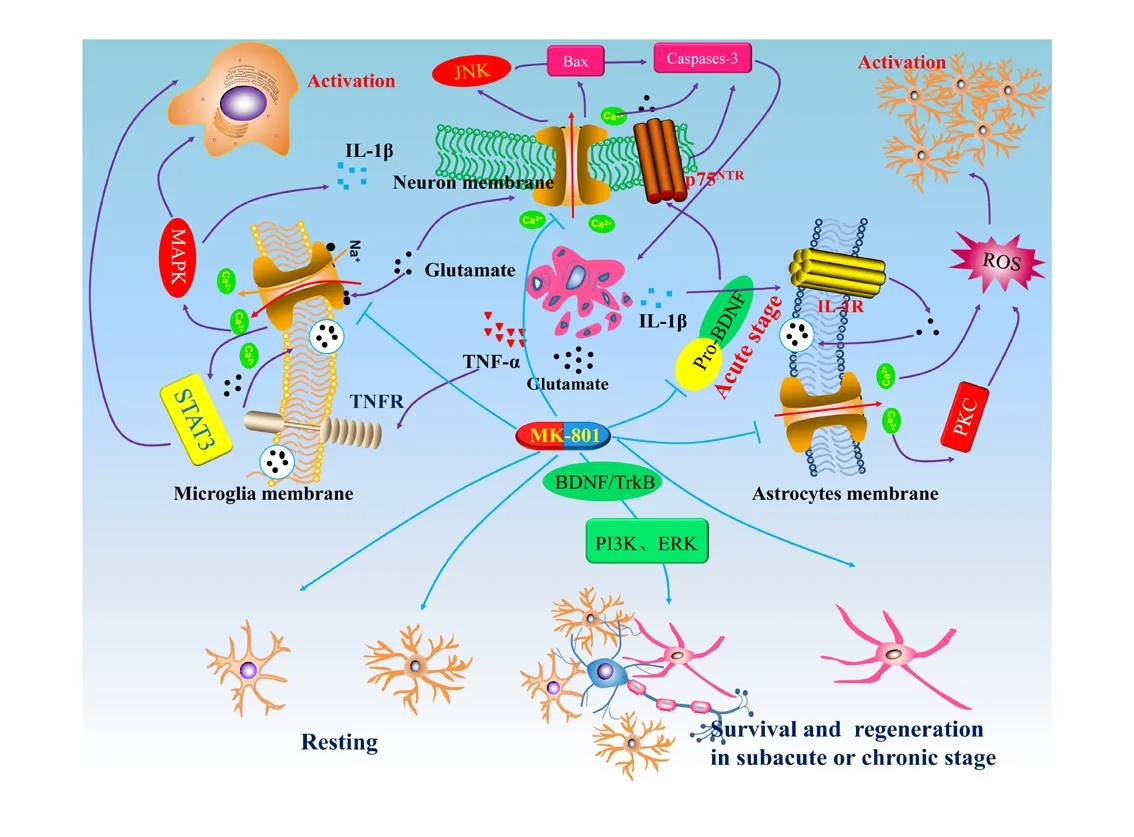
Figure 10 Potential molecular mechanisms underlying the neuroprotective action of MK-801 against acute brain injury.Under pathological conditions, excessive activation of glutamate receptors or Ca2+ influx induces oxidative stress, glial cell activation, and neuronal or oligodendrocyte cell death by affecting downstream signaling pathways, such as PKC, MAPK and PI3K/AKT. MK-801, an antagonist of the NMDA receptor, downregulates PKC and MAPK to suppress neuroinflammation. It also inhibits the JNK and p38 MAPK pathways and downstream apoptosis-related molecules to alleviate neural cell loss, reduce oxidative stress and promote functional recovery. Interestingly, MK-801 seems to have opposing effects on BDNF expression. MK-801 can prevent the excessive increase in BDNF mRNA in the early stage of brain injury and increase BDNF levels in the chronic stage. These contrasting effects reduce acute injury and promote the survival and regeneration of neural cells. IL-1β: Interleukin 1 beta; MAPK: mitogen-activated protein kinase; STAT3: signal transducer and activator of transcription 3; TNFR:tumor necrosis factor receptor; TNF-α: tumor necrosis factor α; JNK:c-Jun N-terminal kinase; Bax: Bcl-2-associated X; BDNF: brain-derived neurotrophic factor; PI3K: phosphatidylinositol 3-kinase; ERK: extracellular signal-regulated kinase; PKC: protein kinase C; ROS: reactive oxygen species.
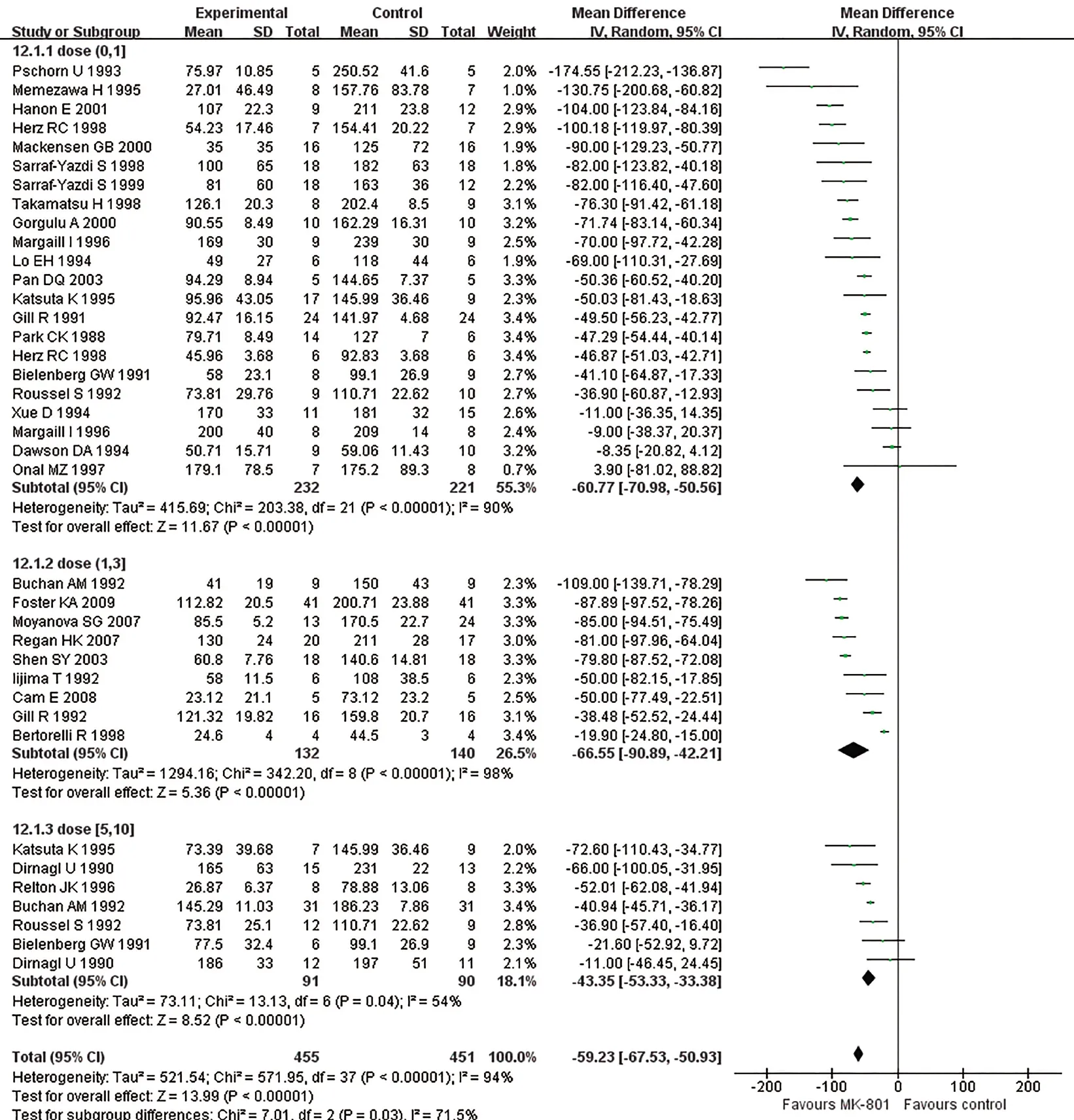
杂志排行
中国神经再生研究(英文版)的其它文章
- Etomidate affects the anti-oxidant pathway to protect retinal ganglion cells after optic nerve transection
- Normal tension glaucoma: from the brain to the eye or the inverse?
- Mesenchymal stromal cell therapy for damaged retinal ganglion cells, is gold all that glitters?
- MicroRNAs as biomarkers of diabetic retinopathy and disease progression
- Diabetic neuropathy research: from mouse models to targets for treatment
- Potential therapeutic roles of retinoids for prevention of neuroinflammation and neurodegeneration in Alzheimer's disease
